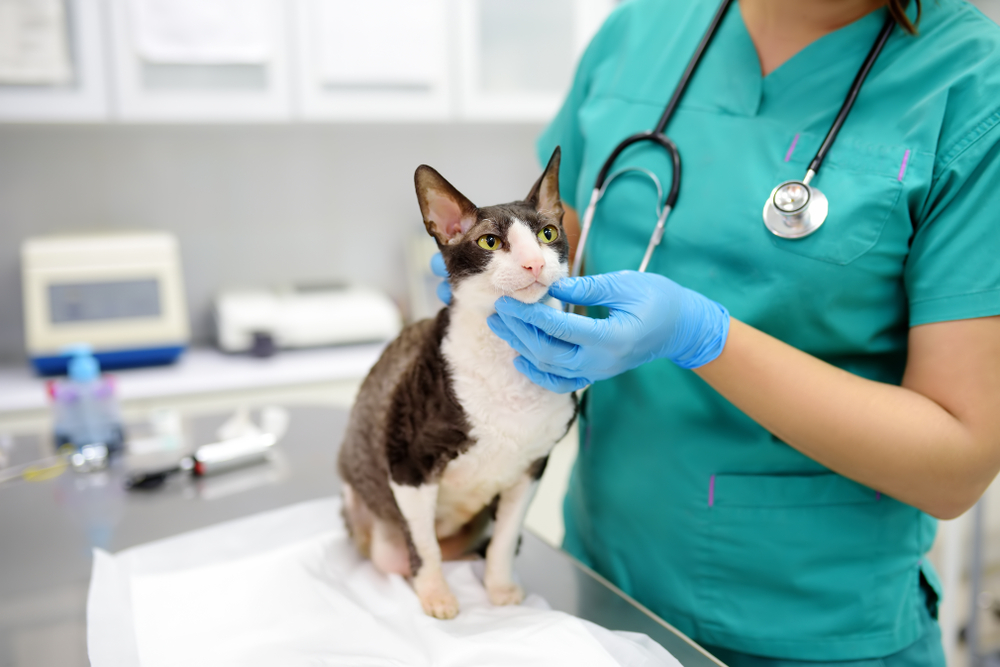Knowing when to say goodbye is often one of the hardest aspects of pet ownership. Perhaps you are wondering if you waited too long or let your pet go too soon. Maybe your pet still has more good days than bad days, and you are seeking guidance as to when the right time is.
Cats may give more subtle signs than dogs when they feel poorly, so we are here to help you decide when your cat is ready to journey to the Rainbow Bridge.

What Is Nasal Cancer?
Nasal cancer is less common in cats than in dogs, making up approximately 1% of all cancers in cats. It is less likely to spread to other tissues and organs in the body. Instead, it grows aggressively in the nasal cavity and sinuses, where it destroys the local tissues, bone, and can even advance into the cat’s brain. Common types of nasal cancer diagnosed in cats include squamous cell carcinoma, adenocarcinoma, and lymphoma.

What Is the Prognosis?
The prognosis for cats diagnosed with nasal cancer depends on the type of tumor and how early it was detected and treated. Without treatment, cats rarely live beyond a few months. Treatment options include surgical removal of the tumor, radiation therapy, and chemotherapy. Treatment is uncommonly curative, however, due to the aggressive nature of the cancer. The average survival time for cats after advanced radiation therapy is 6 to 18 months.

How Will I Know It’s Time?
An important part of knowing when to euthanize is assessing your cat’s quality of life. Quality of life refers to your cat’s health, comfort, happiness, and well-being. It gauges your cat’s interest in things like favorite activities, foods, treats, and interactions with you and other people. When assessing your cat’s quality of life, consider their pain level, eating and drinking habits, mobility, behavior, toileting, interest in preferred activities, and interactions with your family. A good way to keep track of your observations is to keep a daily journal reflecting your cat’s progress.
Lap of Love, which is a practice dedicated to veterinary hospice and in-home euthanasia, has a free online quality of life assessment and daily diary for your use. They also offer a “Quality-of-Life” scale and have an online quality of life assessment questionnaire to provide you with more information if you are unsure if your cat’s cancer is impacting his/her life. Keeping track of your cat’s good days versus bad days is also helpful in deciding when to euthanize. When the bad days outweigh the good days, it may be time to consider euthanasia. A free calendar is available for your use to monitor any changes in your cat’s behavior.
Signs that indicate euthanasia should be considered for cats with nasal cancer include the following:
- Weight loss
- Decreased appetite
- Hiding or avoidance behaviors
- Sleeping more often
- Frequent nose bleeds
- Excessive sneezing
- Uncontrollable pain
- Increased vocalizations
- Lethargy
- Distressed or difficulty breathing
- Depression
- Lack of grooming
- Loss of interest in favorite activities or food
- Confusion, disorientation, or seizures
- Difficulty moving around your home
You also need to consider your quality of life too, and how caring for a cat with nasal cancer may impact your life and those of your family. Are you able to provide supplemental feeding, hydration (subcutaneous fluids), and oxygen on a daily basis if your cat needs it? Can you give your cat all prescribed medications? Are you able to keep your cat clean if he stops grooming or soils himself? Can you help your cat get around the house if his mobility decreases? These are questions you need to think about when deciding the right time to euthanize.

Tips for Keeping Your Cat Comfortable
It can be overwhelming to think of everything you can do to make your cat comfortable.
- Easy access to food, water, and the litter box
- Monitor eating, drinking, and toileting habits
- Give all medications as prescribed
- Observe for any signs of pain or discomfort
- Monitor breathing and appearance of your cat’s nose and facial area
- Keep a daily journal of your cat’s behavior and energy levels
- Avoid exposing your cat to respiratory irritants such as cigarette smoke
- Consult with your veterinarian about end-of-life care (palliative or hospice care)

Conclusion
The goal of euthanasia is to provide a “good death”, free from further pain and suffering. If your cat has more bad days than good days or you are unable to provide further care for your cat, euthanasia should be considered. If your cat’s cancer has progressed beyond the point of being helped with medications and pain control, euthanasia should be considered.
Euthanasia is a gift that allows us to help our pets transition peacefully without suffering or pain. Families pursuing end-of-life care for their cats are not alone, and together, we can find the courage, determination, and strength to provide the best quality of life for our pets as possible.
Featured Image Credit: MakeStory Studio, Shutterstock










